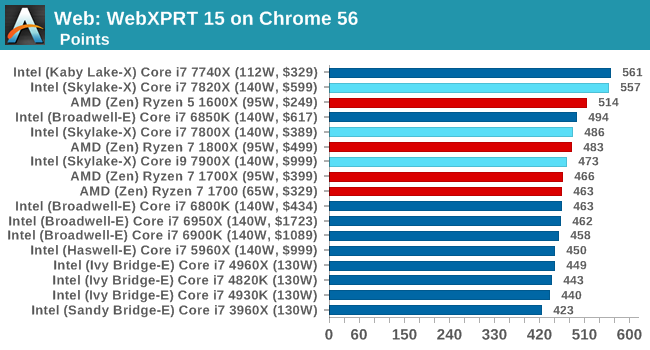The Intel Skylake-X Review: Core i9 7900X, i7 7820X and i7 7800X Tested
by Ian Cutress on June 19, 2017 9:01 AM ESTBenchmarking Performance: CPU Web Tests
One of the issues when running web-based tests is the nature of modern browsers to automatically install updates. This means any sustained period of benchmarking will invariably fall foul of the 'it's updated beyond the state of comparison' rule, especially when browsers will update if you give them half a second to think about it. Despite this, we were able to find a series of commands to create an un-updatable version of Chrome 56 for our 2017 test suite. While this means we might not be on the bleeding edge of the latest browser, it makes the scores between CPUs comparable.
SunSpider 1.0.2
The oldest web-based benchmark in this portion of our test is SunSpider. This is a very basic javascript algorithm tool, and ends up being more a measure of IPC and latency than anything else, with most high-performance CPUs scoring around about the same. The basic test is looped 10 times and the average taken. We run the basic test 4 times.

Sunspider goes after peak frequency most of the time, althoguh there is some variation as it moves into basically becoming a legacy test.
Mozilla Kraken 1.1
Kraken is another Javascript based benchmark, using the same test harness as SunSpider, but focusing on more stringent real-world use cases and libraries, such as audio processing and image filters. Again, the basic test is looped ten times, and we run the basic test four times.

Kraken is more of an intense attack on JS, and still regularly sorts by IPC and frequency.
Google Octane 2.0
Along with Mozilla, as Google is a major browser developer, having peak JS performance is typically a critical asset when comparing against the other OS developers. In the same way that SunSpider is a very early JS benchmark, and Kraken is a bit newer, Octane aims to be more relevant to real workloads, especially in power constrained devices such as smartphones and tablets.

Octane seems to be an optimization target, and with the new Skylake-X it shows.
WebXPRT 2015
While the previous three benchmarks do calculations in the background and represent a score, WebXPRT is designed to be a better interpretation of visual workloads that a professional user might have, such as browser based applications, graphing, image editing, sort/analysis, scientific analysis and financial tools.











264 Comments
View All Comments
zlandar - Monday, June 19, 2017 - link
Glad AMD is lighting a fire under Intel's complacent butt.SaolDan - Monday, June 19, 2017 - link
Can these chips be overclocked? If so can we get some charts? This is my go to site for tech.Despoiler - Monday, June 19, 2017 - link
According to Tom's these things are dogs. AIOs can only handle stock frequencies and Prime95 runs.http://www.tomshardware.com/reviews/intel-core-i9-...
Archie2085 - Monday, June 19, 2017 - link
@ Ryan @ IanHow Come no one is talking about the Power Draw or Performance Per Watt per $$. If that is the Metric Looks Like AMD has a winner achieving 80% Results with a 8 Core Processor Against 10 Core Giants Not to mention at a Fraction of Cost
The Release under such a tearing Hurry Definitely looks like a Knee Jerk Reaction of Zen and Impending Release of Thread Ripper...
I would Expect you to Give a proper review of Thread ripper just as you have not Made any Meaningful mention of it in this article even though Performance leaks have started...
Looks More Like a Marketing Article than a Review of Pros and Cons.
BrokenCrayons - Monday, June 19, 2017 - link
What's with the odd capitalizations?FreckledTrout - Monday, June 19, 2017 - link
I'm not sure how much Performance Per Watt comes into play here but it should at least some. Mostly in the workstation and desktop market its price vs performance. The data center CPU's performance per watt is what it is all about and Intel is in for some trouble if this is a trend that continues into the data center CPU's. AMD may really have some pretty good CPU's in thread ripper and EPYC.Archie2085 - Monday, June 19, 2017 - link
HEDT practically is a workstation chip used for workstations. For Freelancers cost Vs extracted value should have a bearing on the choiceFreckledTrout - Monday, June 19, 2017 - link
No argument that is what I was hinting at wen I said price vs performance. The perf vs power draw ins't top of most workstation users lists, it is mostly how much do I pay for this nn percent improvement in rendering times for example. The performance per watt doesn't matter to to many outside of data centers, well it matters to everyone, but to a much larger degree in data centers.GeorgeH - Monday, June 19, 2017 - link
Thanks for the review. I generally enjoy your perspective, and try to remember to support you by using a browser with no ad blocking, but have to say your website is almost unusable using Microsoft Edge because of the ads (on my ultrabook with an i5-5300u). I had to switch to an ad blocking browser mid stream to actually read your content, which isn't good for anyone.Silma - Monday, June 19, 2017 - link
I was disappointed to find no information on overcloackability, or did I read too fast.I would expect a lesser overcloackability since the frequency & TDP are already pushed.
I'd be glad to be proven wrong.